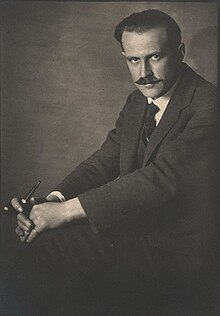Henri Mallard
| Henri Marie Joseph Mallard | |
|---|---|

Portrait of photographer Henri Mallard made in 1916 by Monte Luke
|
|
| Born |
Henri Marie Joseph Mallard 9 February 1884 Australia |
| Died | 21 January 1967 (aged 82) Balmain, Sydney |
| Nationality | Australian |
| Education | self-taught |
| Known for | Photography |
| Notable work |
Nearing their journey's end (1920s) Break-o-day, railway siding, (1939) |
| Movement | Pictorialism, Modernism |
| Spouse(s) | Hilda Mary Cousins |
Henri Marie Joseph Mallard (9 February 1884 – 21 January 1967), was an Australian photographer.
Born in Balmain (Sydney, Australia) of French parents, he came to photography via the industry. Using his French connections, and accent (which was strong owing to his home education), he secured a position in 1900 with Harrington (later Kodak Pty Ltd) as a sales representative to the French consulate. He remained with the company, becoming general manager, until 1952. With ready access to equipment and materials he was an enthusiastic amateur exhibitor by 1904.
He used his business and connections to support other photographers; he was influential on fellow Sydney-sider Frank Hurley, encouraging the budding photographer's interest in the medium and in 1911 recommending Hurley for the position of official photographer to Douglas Mawson's Australasian Antarctic expedition, ahead of himself.; moving to Harington's Melbourne office in 1913, he opened the showrooms to exhibitions, including that of John Kauffmann in 1914.
He was a strong advocate for art photography; on his return to Sydney (1916) he joined (in 1917) The Sydney Camera Circle whose "manifesto" had been drawn up and signed on 28 November 1916 by the founding group of six photographers; Harold Cazneaux, , James Stening, W.S. White, Malcolm McKinnon and James Paton. They pledged "to work and to advance pictorial photography and to show our own Australia in terms of sunlight rather than those of greyness and dismal shadows". He also contributed lectures and technical demonstrations to the New South Wales Photographic Society.
He is best known for his documentation of the Australian icon Sydney Harbour Bridge between the late 1920s to the early 1930s. Photographing from precarious vantage points on the bridge itself, sometimes a hundred metres above Sydney Harbour, his work sets the construction against the harbour and the growing city and uses the figures of the workers to represent the scale of this Depression-era engineering feat. His pictures and film of the Bridge were an intentional historical document and the project was self-generated. Between 1930 and 1932, he produced hundreds of stills and film footage.
...
Wikipedia
